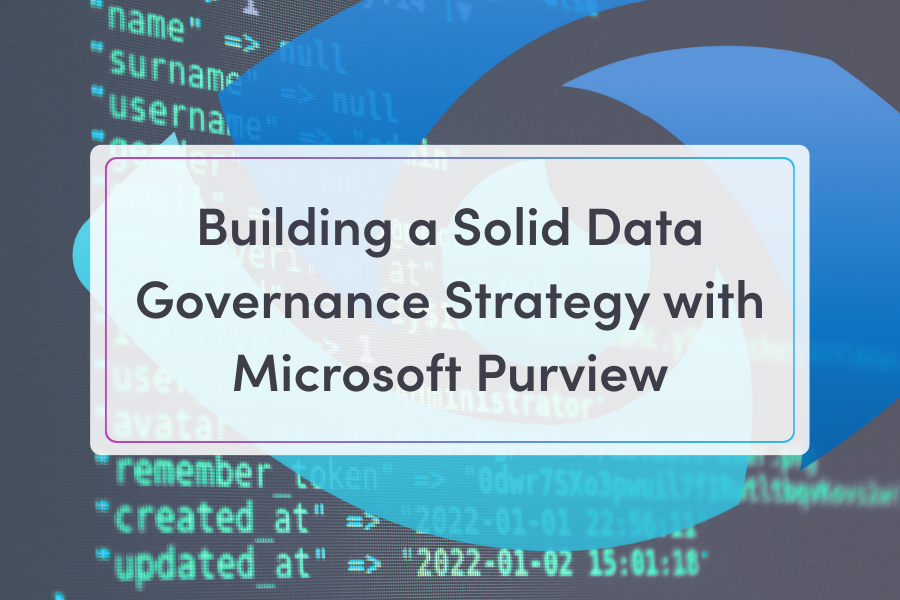Data is more than just an asset in today’s digital landscape; it is the foundation of business innovation, customer trust, and competitive advantage. For small and medium-sized businesses (SMBs), implementing proper data governance is no longer optional—it’s essential. As AI technologies become more accessible and cloud adoption increases, an effective data governance strategy becomes critical.
Microsoft Purview is a comprehensive solution that offers unique benefits. It allows your organization to govern, protect, and manage data across your entire data estate while preparing for an AI-driven future. Here are some ideas around developing an actionable data governance strategy using Microsoft Purview to help your SMB navigate the complexities of data management and position you for success in an increasingly AI-powered business environment.
Partners like Quisitive can help you define and approach the problem strategically.
Understanding Why Data Governance Matters for SMBs
Before implementing data governance, it’s crucial to recognize its significance for your business. Effective data governance ensures that your data is accurate, secure, compliant, and accessible to the right individuals at the right time. For small and medium-sized businesses (SMBs), this translates into several key benefits:
- Improved decision-making based on reliable data
- Reduced risk of regulatory penalties and security breaches
- Enhanced customer trust through proper data management
- The ability to safely adopt AI technologies without compromising sensitive information
- A competitive advantage through data-driven innovation
Without a proper data governance strategy, businesses risk making decisions based on inaccurate data, violating regulations, suffering security breaches, and falling behind competitors who effectively leverage data and AI. The consequences of lacking a robust data governance strategy can be severe for SMBs.

7 Steps to Unlocking the Power of Microsoft Purview for a Comprehensive Data Governance Strategy
Step 1: Assess Your Current Data Landscape
This assessment provides visibility into your data estate, identifies vulnerabilities, and creates the foundation for targeted governance initiatives. A thorough understanding of your data landscape is the first step toward effective governance and AI preparedness. Many SMBs have data scattered across various systems without a clear understanding of what they possess.
TIP: You can’t govern what you do not know exists.
Actionable tasks:
- Conduct a comprehensive data inventory across all systems
- Identify and classify sensitive data that requires special protection
- Document data flows to understand how information moves through your organization
- Evaluate current data management practices and identify gaps
Microsoft Purview’s Data Protection Baseline for Microsoft 365 is a great assessment within the Compliance Manager solution that lets you look at the different Customer Managed Controls and those already implemented by Microsoft as part of the shared responsibility model. Another tool I recommend checking out is Data Security Posture Management for AI, which lets you Discover and secure all AI activity in Microsoft Copilot and other AI apps. Keep your data safe and stay on track with industry regulations. Learn more about DSPM for AI here.
If you are not comfortable with the do-it-yourself approach, another option is to have an external security advisory team help you on your journey. The entire journey will be a partnership between technology, people, and process; there is no one-stop shop that will scale on its own.
Step 2: Define Your Data Governance Framework and Goals
A well-defined framework ensures your efforts deliver tangible benefits aligned with business priorities. It creates accountability and establishes the structure for sustainable data governance that supports current operations and future AI initiatives.
TIP: Data governance initiatives often fail without clear goals and stakeholder buy-in.
Actionable tasks:
- Assemble key stakeholders from various departments (IT, legal, operations)
- Define clear objectives aligned with business goals
- Establish governance roles and responsibilities (data owners, stewards, custodians)
- Select appropriate data governance metrics to measure success
Without a clear understanding from the business leaders as to which customer, regulatory, or legal framework you would, should, or need to comply with, moving on will likely lead to an incomplete solution in the long term. Take the time now to define the required outcomes from your business.
Step 3: Implement Microsoft Purview as Your Data Governance Solution
This comprehensive view helps you identify risks, opportunities, and patterns that would be impossible to detect with siloed approaches. For SMBs with limited Purview, Purview’s automated scanning and classification capabilities save significant time while providing enterprise-grade governance.
TIP: Microsoft Purview provides unified visibility across your entire data estate, including multi-cloud and SaaS environments.
Actionable tasks:
- Set up a Microsoft Purview Enterprise instance
- Assign users to the Data Governance Admin role
- Create governance domains aligned with your business structure
- Register and scan your data sources to build a comprehensive data map
- Build data products that package related data assets for specific business purposes
Use your Cloud Service Provider, Managed Security Services Provider, or Microsoft to ensure you have the proper licenses enabled to get the desired results from the solutions. Depending on your business and the other technologies you have already implemented, you may need to manually add connectors for your digital estate.
Step 4: Develop Data Quality and Protection Policies
Automated data protection policies ensure consistent enforcement across your organization without relying on individual compliance, which is especially valuable for SMBs with limited security resources. This automated protection can provide relief, knowing your data is consistently and comprehensively secured.
TIP: High-quality, well-protected data builds trust with customers and partners while reducing operational inefficiencies. See where your business falls on the Data Maturity Model with this infographic.
Actionable tasks:
- Establish data quality rules and profiling for critical assets
- Implement Microsoft Purview Data Loss Prevention policies
- Configure Microsoft Purview Information Protection with sensitivity labels
- Set up data lifecycle management policies for retention and deletion
- Create data access controls based on the principle of least privilege
Automation can be a lifeline for businesses with large amounts of data that they might need to discover, identify, classify, and act on. Still, without a defined strategy going into the process, you could end up frustrated that it might not work as intended or as you wanted it to.
If you do not have the resources in-house, having project-based support to get you spun up from nothing to something could help enable your team to keep it running from there.
Step 5: Prepare Your Data Governance Strategy for AI Integration
Proper AI governance enables your organization to safely adopt productivity-enhancing AI tools while protecting intellectual property and sensitive information, balancing innovation with necessary risk management. Having visibility into how your business is currently using AI services, as well as how it wants to use AI services, will be critical here.
Microsoft’s Defender for Cloud Applications or other Cloud Access Security Brokers can monitor your organizational traffic or endpoints to identify, block, or provide guardrails around.
TIP: AI tools present new data security challenges. Without proper governance, employees might inadvertently share sensitive information with these systems. Learn more about implemeting secure AI with this article.
Actionable tasks:
- Enable Microsoft Purview AI Hub to monitor AI activity across your organization
- Implement ready-to-use policies to protect data in AI prompts
- Install the Microsoft Purview browser extension to monitor third-party AI site usage
- Use communication compliance to detect unethical behavior in AI interactions
- Create guidelines for responsible AI usage
As with other tools, you need to think through what data you have, who needs to access it, and what they can do with it. From there, you can define what processing is needed and which AI solutions can help you achieve the desired outcome. AI solutions alone can’t magically do it for you, but they can help you achieve your desired outcomes faster with the right toolset.
Step 6: Embrace Cloud-First Data Security
Automated security processes reduce the burden on IT staff while providing more comprehensive coverage. Cloud solutions also scale seamlessly with your business growth, allowing you to focus on innovation rather than infrastructure management. This sense of control over your security measures can provide a significant peace of mind.
TIP: Cloud-based security offers SMBs enterprise-grade protection without requiring massive infrastructure investments.
Actionable tasks:
- Migrate on-premises data to secure cloud environments
- Implement cloud-specific security measures like encryption and multi-factor authentication
- Automate security monitoring and compliance processes
- Leverage Microsoft Purview Data Security Posture Management
- Regularly review and optimize cloud security settings
Like with your AI strategy, your cloud strategy should be methodical. Just moving your compute, data, and services to the cloud will not solve all your problems.
With the shared responsibility approach, your Cloud Service Providers will handle some of the controls for you, and you will need to understand which controls are left to you based on the type of service you are using.
By refactoring your solutions or compute processes to take advantage of your cloud service offerings, you can better achieve the touted benefits of cloud scale, resiliency, and cost optimization.
Step 7: Foster a Data-Driven Culture
A data-driven culture encourages innovation, improves decision-making at all levels, and reduces the likelihood of costly data mistakes or breaches. When employees understand the value of data and their role in protecting it, they become active participants in governance rather than obstacles to overcome.
TIP: Even the best technical solutions will fail without user adoption.
Actionable tasks:
- Provide training on data governance principles and tools
- Create intuitive processes that make compliance easy
- Recognize and reward responsible data-handling practices
- Lead by example with executive sponsorship
- Regularly communicate the importance and benefits of data governance
AI and data governance should be integrated into your other governance practices so that stakeholders can understand the implications of their decision-making, both positively and negatively. Data can be both an asset and a liability if not properly managed.
Implementing a Phased Approach to Your Data Governance Strategy
Implementing all these steps at once may seem overwhelming for small and medium-sized businesses (SMBs) with limited resources. Consider this weekly implementation plan to help you get started, this will be an agile and ongoing process within your organization, but this framework will help you get started.
Weeks 1-2
- Assign users to the Data Governance Admin role
- Create your first governance domain
- Begin data inventory and classification
Weeks 2-3
- Register and scan key data sources
- Create initial data products
- Implement basic data access policies
Weeks 3-4
- Review data quality and set up profiling
- Establish governance domain owners
- Focus on data discovery and understanding capabilities
Weeks 4-5
- Enable AI monitoring and protection
- Develop data quality rules for critical assets
- Begin employee training on data governance principles

Take Continuous Improvement Actions to Maintain Your Data Governance Strategy
Before implementing AI solutions, remember that having solid data governance will become a critical factor in its long-term success. Effective data governance ensures your data is accurate, secure, compliant, and accessible to the right people at the right time. For small and medium-sized businesses (SMBs), this translates to several key benefits:
- Improved decision-making based on reliable data
- Reduced risk of regulatory penalties and security breaches
- Enhanced customer trust through proper data management
- The ability to safely adopt AI technologies without compromising sensitive information
- A competitive advantage through data-driven innovation
Without proper governance, businesses risk making decisions based on inaccurate data, violating regulations, suffering security breaches, and falling behind competitors who effectively leverage data and AI. The consequences of lacking a robust data governance strategy can be severe for SMBs.
Conclusion
Data can be the most valuable asset your SMB possesses. Implementing a strong data governance strategy with Microsoft Purview protects this asset and transforms it into a competitive advantage. From ensuring regulatory compliance to enabling safe AI adoption and securing your cloud environment, proper data governance is the foundation for sustainable growth and innovation.
By following these actionable steps, your SMB can establish an enterprise-grade data governance strategy that prepares you for an AI-driven future while maintaining the agility and flexibility that gives smaller businesses their edge. The journey to mature data governance is continuous. Still, with Microsoft Purview, you have a powerful ally to simplify and streamline the process.
Remember, the goal isn’t governance for its sake—it’s about creating the conditions where data becomes a catalyst for business success rather than a source of risk. Start small, focus on high-value use cases, and build your governance capabilities in incremental organization’s data maturity evolves.
As AI becomes increasingly embedded in business operations, the organizations that thrive will be those with a solid data foundation. Microsoft Purview provides the tools to build that foundation, ensuring your SMB is ready to compete and innovate in an AI-powered world.

;)



